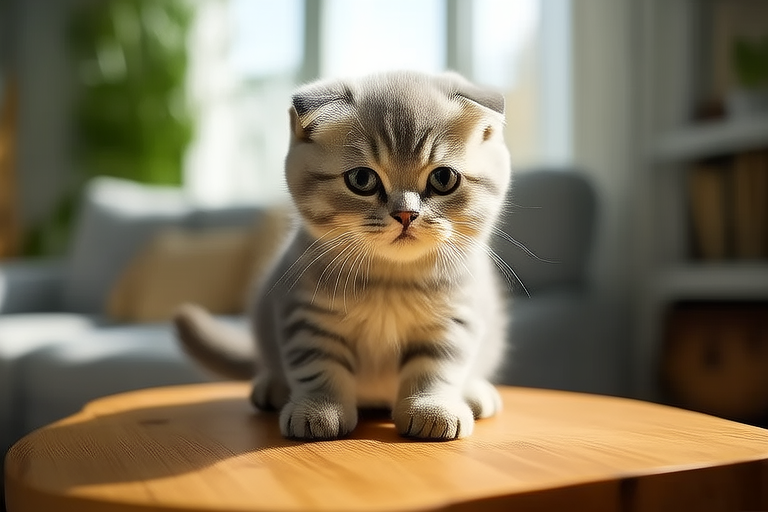The Unique Appeal of Scottish Folds: Why These Cats Are Catching Hearts Worldwide
With their unique folded ears and charming personalities, Scottish Folds have captured the hearts of cat enthusiasts worldwide. This article delves into the distinctive features that make this breed stand out, explores their temperament, and shares the rich history behind their development. We’ll also discuss health considerations and common misconceptions about these delightful felines.
Distinctive Physical Traits
Scottish Folds are instantly recognizable due to their signature folded ears, which give them a sweet, owl-like appearance. These adorable cats come in two types: straight-eared and folded-eared. The fold is caused by a genetic mutation that affects the ear cartilage, causing the tips to fold forward and downward. While all kittens are born with straight ears, they begin to fold at around three weeks old if they carry the gene responsible for the trait.
Besides their ears, Scottish Folds have round faces, large expressive eyes, and short, dense coats that can be found in various colors and patterns. Their compact bodies are muscular yet graceful, making them agile despite their stocky appearance. Their paws are often described as rabbit-like, adding another layer of uniqueness to their already striking looks.
Temperament and Companionship
Scottish Folds are known for their friendly and adaptable nature, making them ideal companions for families and individuals alike. They are typically calm, affectionate, and enjoy being around people, often following their owners from room to room. These cats are also intelligent and curious, which means they tend to get along well with other pets and children.
One owner, Sarah Thompson, shared her experience with her Scottish Fold named Whiskers. “Whiskers is the perfect family pet,” she said. “He’s always up for a cuddle and loves to play with my kids. He’s incredibly patient and gentle, even when the little ones get a bit too excited.” This sentiment is echoed by many owners who find Scottish Folds to be loving and devoted pets.
History of the Breed
The history of Scottish Folds dates back to the early 1960s when a barn cat named Susie was discovered near Coupar Angus, Scotland. Susie had unusually folded ears, and her offspring inherited the trait. A local shepherd named William Ross took notice of these cats and began breeding them. In 1966, he registered the breed with the Governing Council of the Cat Fancy (GCCF) in Britain.
However, due to concerns about genetic issues associated with the folded ear gene, the GCCF suspended registration of the breed in 1971. Despite this setback, dedicated breeders continued working with Scottish Folds in North America, where they gained popularity. The International Cat Association (TICA) recognized the breed in 1978, followed by the Cat Fanciers’ Association (CFA) in 1991.
Health Considerations
While Scottish Folds are generally healthy, there are some health considerations to keep in mind. The most significant concern is osteochondrodysplasia, a condition affecting the cartilage and bones, which can lead to joint problems. To mitigate this risk, reputable breeders carefully select breeding pairs and avoid mating related cats.
Regular veterinary check-ups, a balanced diet, and plenty of exercise are essential for maintaining the health of Scottish Folds. Providing them with appropriate toys and stimulating activities can help prevent obesity and keep their joints healthy. It’s important to note that not all Scottish Folds will develop joint issues, but being aware of the potential risks allows owners to take proactive steps in ensuring their cat’s well-being.
Common Misconceptions
There are several misconceptions surrounding Scottish Folds. One common myth is that all Scottish Folds suffer from severe health problems. While it’s true that some cats may face challenges, responsible breeding practices have significantly reduced the incidence of serious health issues. Another misconception is that Scottish Folds cannot be shown in cat shows. However, both straight-eared and folded-eared Scottish Folds can compete in TICA shows, while only folded-eared cats are eligible in CFA shows.
Real-Life Stories
Another owner, Mark Johnson, spoke about his experience with his Scottish Fold, Luna. “Luna has been a wonderful addition to our home,” he said. “She’s very social and loves to participate in family activities. Her playful demeanor never fails to brighten our days.” These personal accounts highlight the positive impact Scottish Folds can have on their owners’ lives.
Summary
In conclusion, Scottish Folds are captivating creatures with a unique combination of charm and personality. Their distinctive folded ears, coupled with their friendly and adaptable temperaments, make them irresistible to cat lovers around the world. As more people discover the joys of owning a Scottish Fold, it’s no surprise that this breed is gaining popularity globally.
Whether you’re looking for a loyal companion or simply want to add a touch of whimsy to your home, Scottish Folds offer a special kind of companionship that’s hard to resist. With proper care and attention, these delightful cats can bring years of happiness and joy to their human families.
